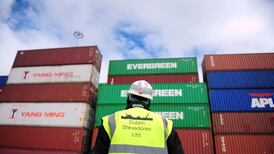Just weeks from the US elections, veteran Nasa astronauts Butch Wilmore and Suni Williams are arranging to cast early ballots by email from the International Space Station (ISS) 400km above the Earth’s surface.
The pair have been stranded there since their Boeing spacecraft encountered problems on its journey into orbit in June.
By the time they hitch a ride home next February their new president will have been inaugurated.
And by then, too, Boeing will know whether its plan, unveiled this week, will help the former north star of US manufacturing avoid another type of celestial event: becoming a so-called fallen angel.
READ MORE
The debt market term for a once-highly-rated company that has fallen to junk-bond status – triggering higher borrowing costs – has been hanging for some time over Boeing, which has also seen its share price plunge more than 55 per cent over the past six years as it lurched from one crisis to the next.
However, the threat within the past five weeks by Moody’s and S&P Global Ratings that they might cut the company to junk – making it the biggest ever fallen angel with $52 billion (€48 billion) of debt – prompted Boeing’s new chief executive, Kelly Ortberg, to announce this week that the company plans to raise as much as $25 billion of funds. Some $10 billion of this is expected to come from a share sale in the coming months.
A costly machinist strike, halting production of most Boeing aircraft and costing the company about $50 million a day, entered its sixth week on Friday. It could not come at a worse time, as the once mighty manufacturer was already running behind on production before workers downed tools. This was being driven by delays from the maker of fuselages (the main aircraft body), Spirit AeroSystems, for its bestselling 737 Max, amid heightened checks after a door plug blowout on an Alaska Airlines flight in January.
[ Boeing to raise up to $25bn to shore up balance sheetOpens in new window ]
Boeing was finishing an average of 24 such aircraft a month before the strike on pay (the main union is demanding a 40 per cent increase) and pensions – well off its target to reach 38 by the end of the year. The discovery and reworking of faulty junction boxes carrying electric cables through aircraft didn’t help.
It’s all minor, of course, compared with the fallout from the crashes of two 737 Max aircraft operated by Indonesian and Ethiopian carriers in 2018 and 2019 – killing 346 people and leading to the aircraft being grounding globally for 21 months. Both were linked to a flight control system about which Boeing later admitted it had deceived regulators. The direct cost to Boeing is estimated to top $20 billion, including compensation to victims’ families, fines and legal fees. Indirect costs from cancelled orders were also in the tens of billions.
The failures and mishaps are largely attributed to a strategy pursued by successive chief executives in recent decades of outsourcing functions and moving from being an engineering-led company to one driven by the bottom line.
This culture shift has been traced back to Boeing’s 1997 merger with aerospace company McDonnell Douglas. It was clearly signposted by the moving of the corporate headquarters to Chicago four years later, almost 3,400km east of the Seattle factory floor, and the spinning-off of Spirit AeroSystems into a separate company in 2005.
Boeing agreed in July to reacquire Spirit in a $4.7 billion stock-based deal under a plan to reform its safety problems and tighten its production line. However, it is not expected to close until the middle of next year.
Boeing, one half of the global duopoly with Airbus, isn’t going away. And while Airbus has outpaced its rival for five straight years in aircraft orders and deliveries, it, too, has had production challenges as a result of supply-chain bottlenecks and inflation. Both also have problematic defence divisions, spanning military aircraft to spacecraft. Boeing’s Starliner aircraft faces an uncertain future, to say the least, as the two astronauts orbit the Earth 16 times a day on the ISS.
And while analysts such as RBC Capital Markets’ Ken Herbert say the capital-raising plans may be positive for the company’s stock (its shares rallied as much as 5 per cent this week), they expect investors to largely hang back until visibility improves.
Ortberg has won praise for basing himself in Seattle and meeting employees at all levels since taking over in August – even as his machinists strike
Boeing is set to report quarterly figures next Wednesday. But Ortberg – an engineer by background whose career has spanned chipmaker Texas Instruments to leading Collins Aerospace – is unlikely to be in a position by then to set out a comprehensive strategy, given the distraction of the strikes.
He is also on the back foot in negotiations with unions. They know he faces challenges raising equity until a line is drawn under the dispute.
Still, Ortberg has won praise for basing himself in Seattle (the headquarters moved again two years ago, to Arlington, Virginia) and meeting employees at all levels since taking over in August – even as his machinists strike.
“Building connections down to the factory floor will be essential. We still see this as Ortberg’s number-one challenge,” Douglas Harned, an analyst with Bernstein, said in a report this week. “We have yet to see an outsider at Boeing who can truly connect at multiple levels in the organisation. His predecessors were unable to do this, which contributed to the situation the company is in today.”
- Sign up for the Business Today newsletter and get the latest business news and commentary in your inbox every weekday morning
- Opt in to Business push alerts and have the best news, analysis and comment delivered directly to your phone
- Join The Irish Times on WhatsApp and stay up to date
- Our Inside Business podcast is published weekly – Find the latest episode here

















